Audit and Assurance Report: Independence, Objectivity, and Ethics
VerifiedAdded on 2023/06/18
|14
|3946
|270
Report
AI Summary
This report delves into the critical aspects of auditing and assurance, emphasizing auditor independence and objectivity. It examines factors influencing auditor credibility, disqualifications under the Companies Act 2006, and threats to objectivity in internal and external audits. Substantive procedures for addressing inventory misstatements and indicators of a 'going concern' issue are discussed. The report also outlines analytical procedures for assessing going concern status and the impact on audit reports. The report concludes by highlighting the importance of ethical conduct and adherence to auditing standards to maintain the integrity and reliability of financial reporting.
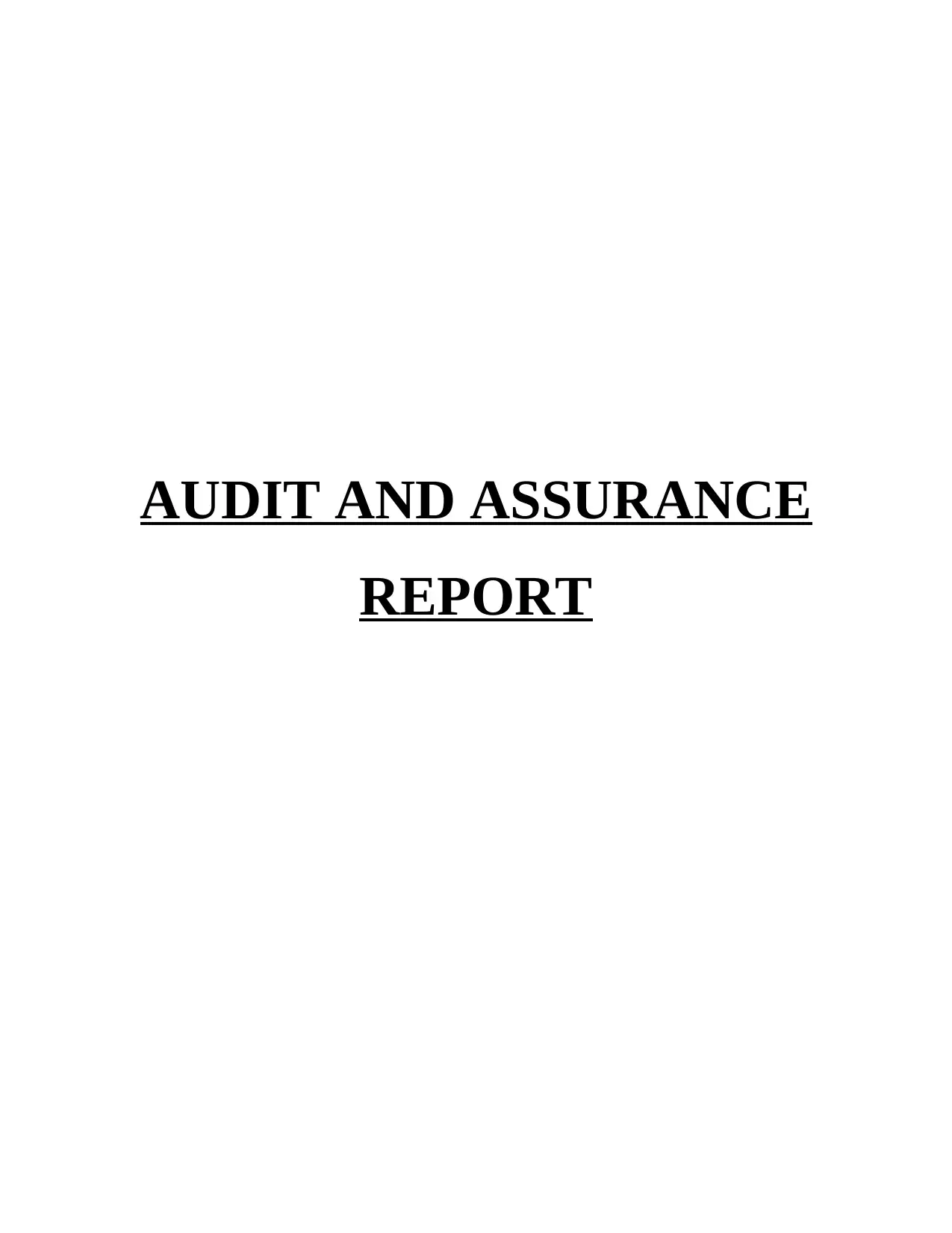
AUDIT AND ASSURANCE
REPORT
REPORT
Paraphrase This Document
Need a fresh take? Get an instant paraphrase of this document with our AI Paraphraser
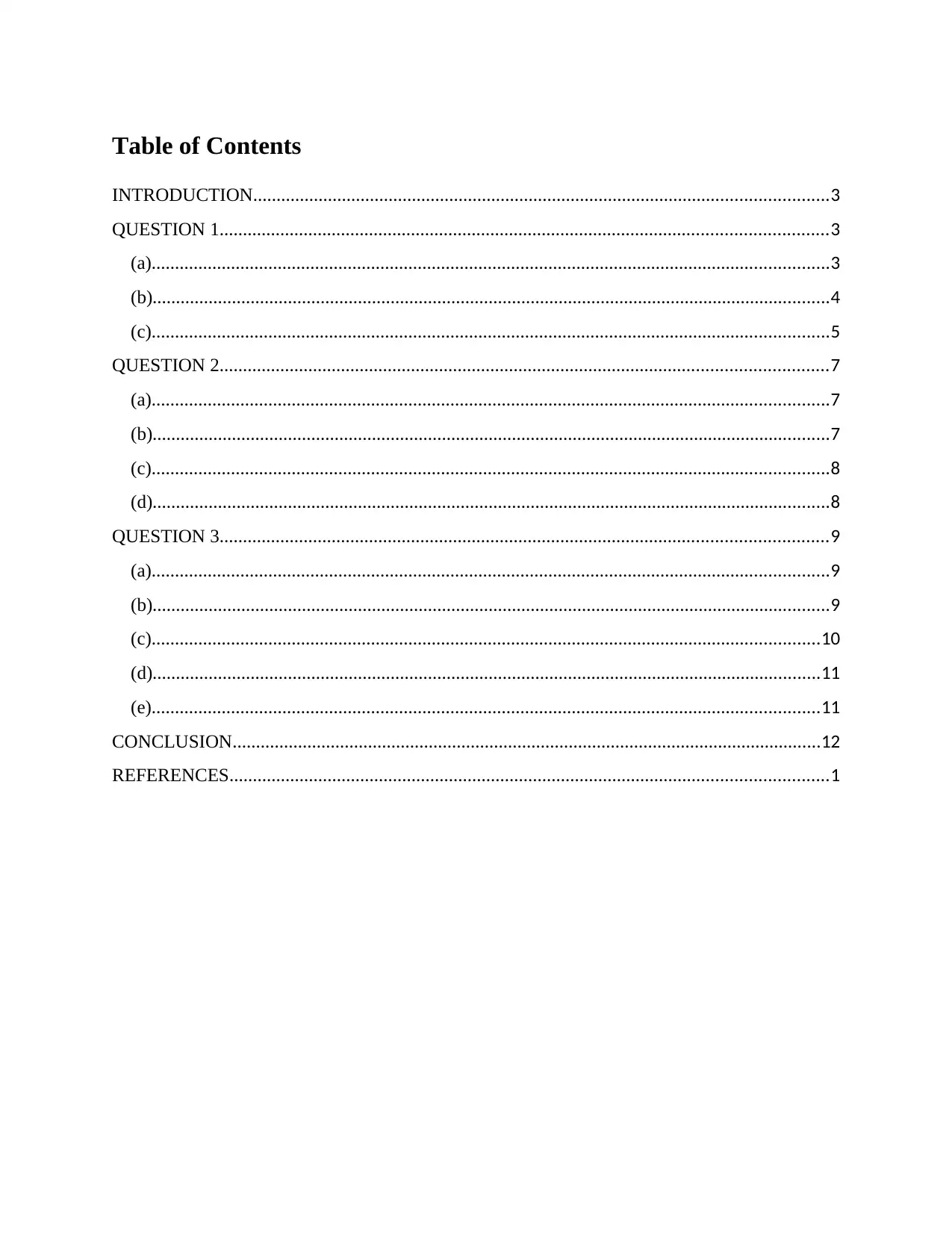
Table of Contents
INTRODUCTION...........................................................................................................................3
QUESTION 1..................................................................................................................................3
(a).................................................................................................................................................3
(b).................................................................................................................................................4
(c).................................................................................................................................................5
QUESTION 2..................................................................................................................................7
(a).................................................................................................................................................7
(b).................................................................................................................................................7
(c).................................................................................................................................................8
(d).................................................................................................................................................8
QUESTION 3..................................................................................................................................9
(a).................................................................................................................................................9
(b).................................................................................................................................................9
(c)...............................................................................................................................................10
(d)...............................................................................................................................................11
(e)...............................................................................................................................................11
CONCLUSION..............................................................................................................................12
REFERENCES................................................................................................................................1
INTRODUCTION...........................................................................................................................3
QUESTION 1..................................................................................................................................3
(a).................................................................................................................................................3
(b).................................................................................................................................................4
(c).................................................................................................................................................5
QUESTION 2..................................................................................................................................7
(a).................................................................................................................................................7
(b).................................................................................................................................................7
(c).................................................................................................................................................8
(d).................................................................................................................................................8
QUESTION 3..................................................................................................................................9
(a).................................................................................................................................................9
(b).................................................................................................................................................9
(c)...............................................................................................................................................10
(d)...............................................................................................................................................11
(e)...............................................................................................................................................11
CONCLUSION..............................................................................................................................12
REFERENCES................................................................................................................................1
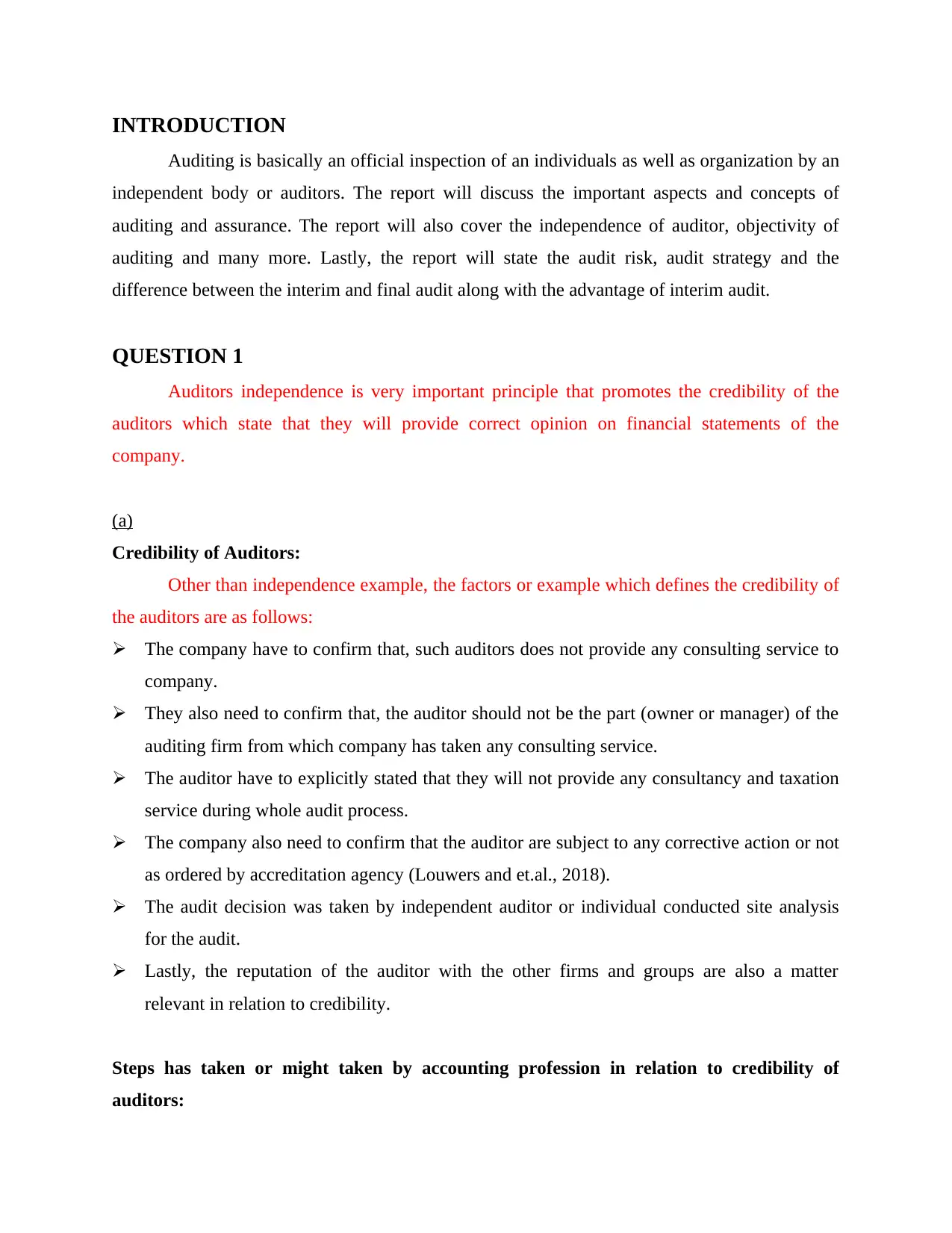
INTRODUCTION
Auditing is basically an official inspection of an individuals as well as organization by an
independent body or auditors. The report will discuss the important aspects and concepts of
auditing and assurance. The report will also cover the independence of auditor, objectivity of
auditing and many more. Lastly, the report will state the audit risk, audit strategy and the
difference between the interim and final audit along with the advantage of interim audit.
QUESTION 1
Auditors independence is very important principle that promotes the credibility of the
auditors which state that they will provide correct opinion on financial statements of the
company.
(a)
Credibility of Auditors:
Other than independence example, the factors or example which defines the credibility of
the auditors are as follows:
The company have to confirm that, such auditors does not provide any consulting service to
company.
They also need to confirm that, the auditor should not be the part (owner or manager) of the
auditing firm from which company has taken any consulting service.
The auditor have to explicitly stated that they will not provide any consultancy and taxation
service during whole audit process.
The company also need to confirm that the auditor are subject to any corrective action or not
as ordered by accreditation agency (Louwers and et.al., 2018).
The audit decision was taken by independent auditor or individual conducted site analysis
for the audit.
Lastly, the reputation of the auditor with the other firms and groups are also a matter
relevant in relation to credibility.
Steps has taken or might taken by accounting profession in relation to credibility of
auditors:
Auditing is basically an official inspection of an individuals as well as organization by an
independent body or auditors. The report will discuss the important aspects and concepts of
auditing and assurance. The report will also cover the independence of auditor, objectivity of
auditing and many more. Lastly, the report will state the audit risk, audit strategy and the
difference between the interim and final audit along with the advantage of interim audit.
QUESTION 1
Auditors independence is very important principle that promotes the credibility of the
auditors which state that they will provide correct opinion on financial statements of the
company.
(a)
Credibility of Auditors:
Other than independence example, the factors or example which defines the credibility of
the auditors are as follows:
The company have to confirm that, such auditors does not provide any consulting service to
company.
They also need to confirm that, the auditor should not be the part (owner or manager) of the
auditing firm from which company has taken any consulting service.
The auditor have to explicitly stated that they will not provide any consultancy and taxation
service during whole audit process.
The company also need to confirm that the auditor are subject to any corrective action or not
as ordered by accreditation agency (Louwers and et.al., 2018).
The audit decision was taken by independent auditor or individual conducted site analysis
for the audit.
Lastly, the reputation of the auditor with the other firms and groups are also a matter
relevant in relation to credibility.
Steps has taken or might taken by accounting profession in relation to credibility of
auditors:
⊘ This is a preview!⊘
Do you want full access?
Subscribe today to unlock all pages.

Trusted by 1+ million students worldwide
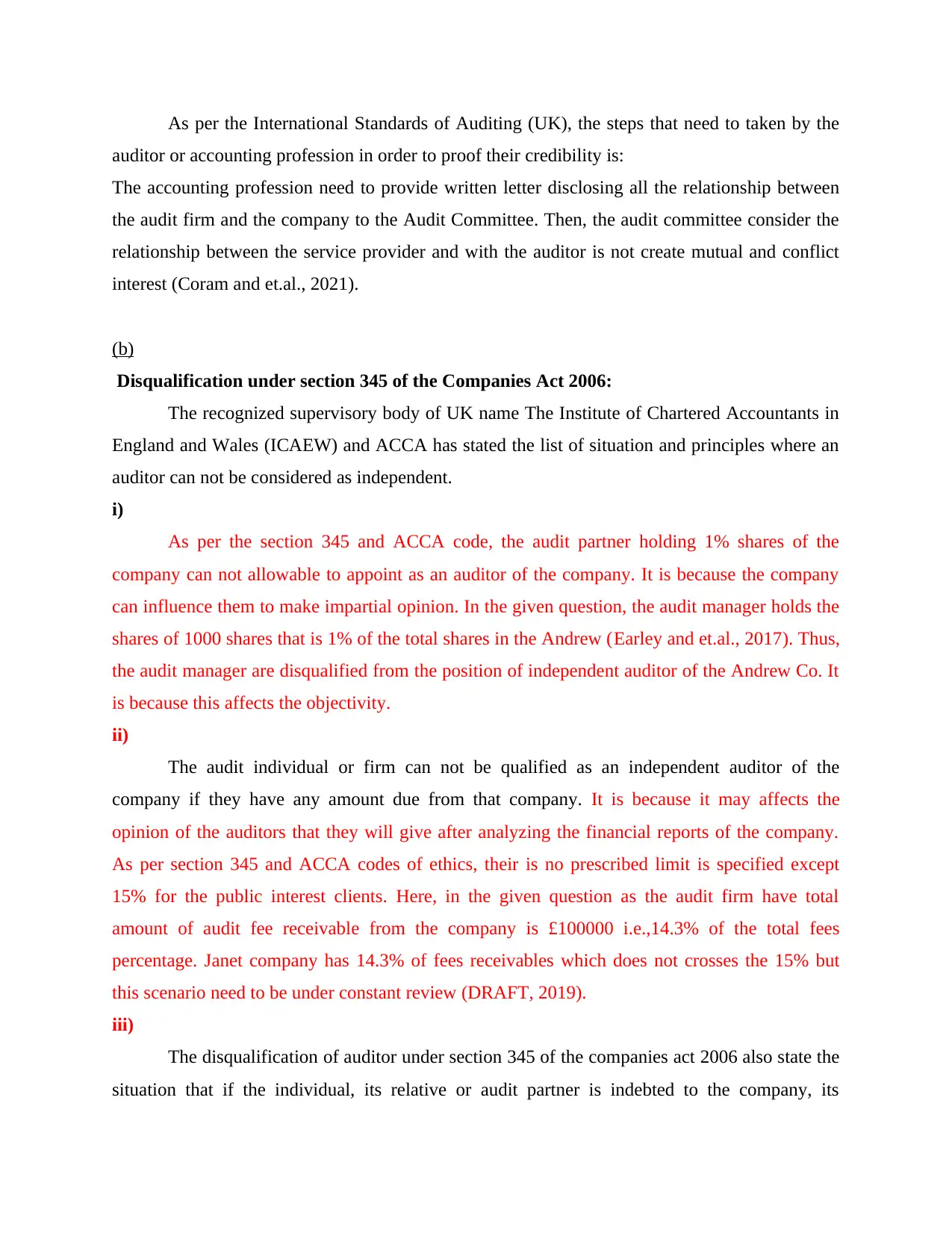
As per the International Standards of Auditing (UK), the steps that need to taken by the
auditor or accounting profession in order to proof their credibility is:
The accounting profession need to provide written letter disclosing all the relationship between
the audit firm and the company to the Audit Committee. Then, the audit committee consider the
relationship between the service provider and with the auditor is not create mutual and conflict
interest (Coram and et.al., 2021).
(b)
Disqualification under section 345 of the Companies Act 2006:
The recognized supervisory body of UK name The Institute of Chartered Accountants in
England and Wales (ICAEW) and ACCA has stated the list of situation and principles where an
auditor can not be considered as independent.
i)
As per the section 345 and ACCA code, the audit partner holding 1% shares of the
company can not allowable to appoint as an auditor of the company. It is because the company
can influence them to make impartial opinion. In the given question, the audit manager holds the
shares of 1000 shares that is 1% of the total shares in the Andrew (Earley and et.al., 2017). Thus,
the audit manager are disqualified from the position of independent auditor of the Andrew Co. It
is because this affects the objectivity.
ii)
The audit individual or firm can not be qualified as an independent auditor of the
company if they have any amount due from that company. It is because it may affects the
opinion of the auditors that they will give after analyzing the financial reports of the company.
As per section 345 and ACCA codes of ethics, their is no prescribed limit is specified except
15% for the public interest clients. Here, in the given question as the audit firm have total
amount of audit fee receivable from the company is £100000 i.e.,14.3% of the total fees
percentage. Janet company has 14.3% of fees receivables which does not crosses the 15% but
this scenario need to be under constant review (DRAFT, 2019).
iii)
The disqualification of auditor under section 345 of the companies act 2006 also state the
situation that if the individual, its relative or audit partner is indebted to the company, its
auditor or accounting profession in order to proof their credibility is:
The accounting profession need to provide written letter disclosing all the relationship between
the audit firm and the company to the Audit Committee. Then, the audit committee consider the
relationship between the service provider and with the auditor is not create mutual and conflict
interest (Coram and et.al., 2021).
(b)
Disqualification under section 345 of the Companies Act 2006:
The recognized supervisory body of UK name The Institute of Chartered Accountants in
England and Wales (ICAEW) and ACCA has stated the list of situation and principles where an
auditor can not be considered as independent.
i)
As per the section 345 and ACCA code, the audit partner holding 1% shares of the
company can not allowable to appoint as an auditor of the company. It is because the company
can influence them to make impartial opinion. In the given question, the audit manager holds the
shares of 1000 shares that is 1% of the total shares in the Andrew (Earley and et.al., 2017). Thus,
the audit manager are disqualified from the position of independent auditor of the Andrew Co. It
is because this affects the objectivity.
ii)
The audit individual or firm can not be qualified as an independent auditor of the
company if they have any amount due from that company. It is because it may affects the
opinion of the auditors that they will give after analyzing the financial reports of the company.
As per section 345 and ACCA codes of ethics, their is no prescribed limit is specified except
15% for the public interest clients. Here, in the given question as the audit firm have total
amount of audit fee receivable from the company is £100000 i.e.,14.3% of the total fees
percentage. Janet company has 14.3% of fees receivables which does not crosses the 15% but
this scenario need to be under constant review (DRAFT, 2019).
iii)
The disqualification of auditor under section 345 of the companies act 2006 also state the
situation that if the individual, its relative or audit partner is indebted to the company, its
Paraphrase This Document
Need a fresh take? Get an instant paraphrase of this document with our AI Paraphraser
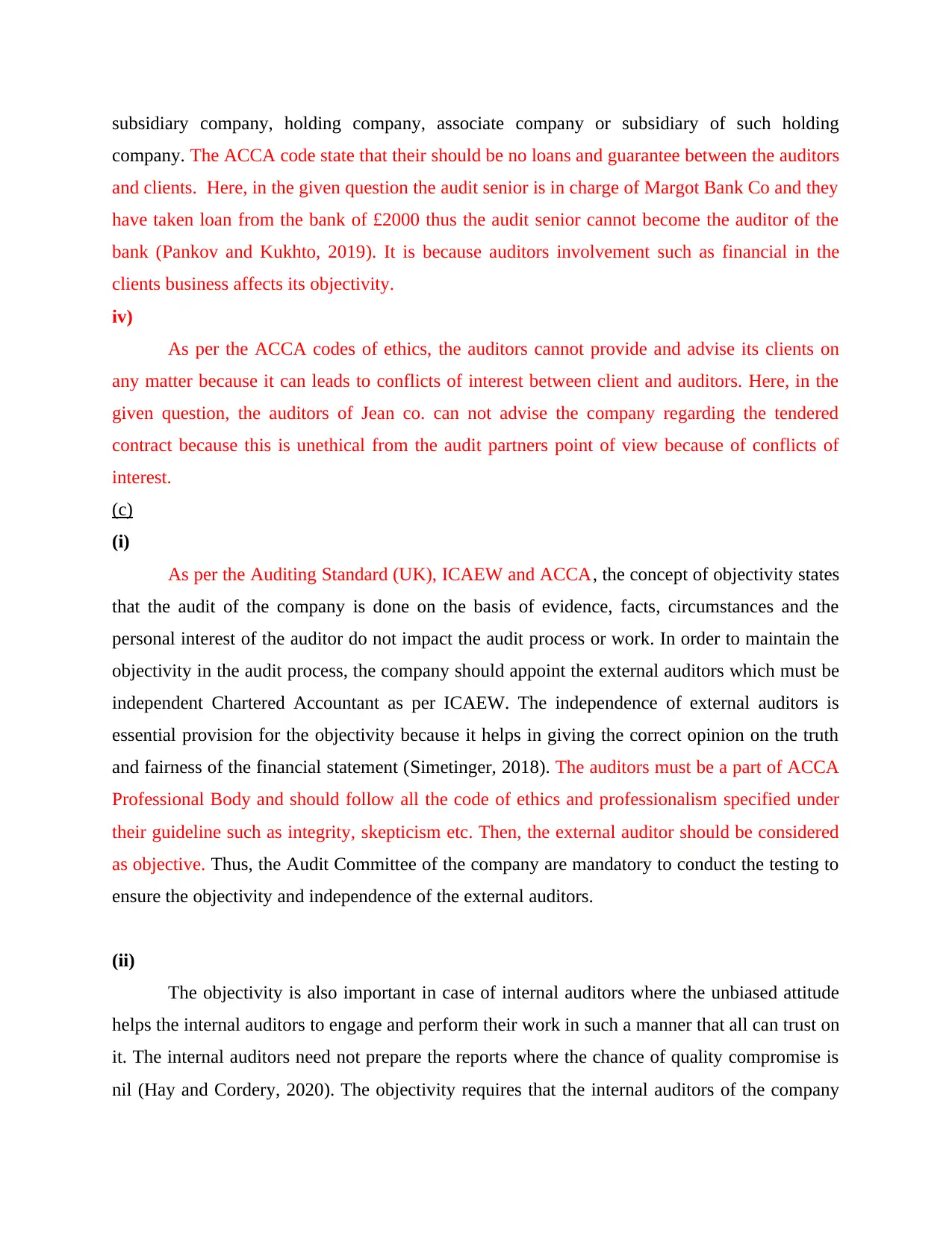
subsidiary company, holding company, associate company or subsidiary of such holding
company. The ACCA code state that their should be no loans and guarantee between the auditors
and clients. Here, in the given question the audit senior is in charge of Margot Bank Co and they
have taken loan from the bank of £2000 thus the audit senior cannot become the auditor of the
bank (Pankov and Kukhto, 2019). It is because auditors involvement such as financial in the
clients business affects its objectivity.
iv)
As per the ACCA codes of ethics, the auditors cannot provide and advise its clients on
any matter because it can leads to conflicts of interest between client and auditors. Here, in the
given question, the auditors of Jean co. can not advise the company regarding the tendered
contract because this is unethical from the audit partners point of view because of conflicts of
interest.
(c)
(i)
As per the Auditing Standard (UK), ICAEW and ACCA, the concept of objectivity states
that the audit of the company is done on the basis of evidence, facts, circumstances and the
personal interest of the auditor do not impact the audit process or work. In order to maintain the
objectivity in the audit process, the company should appoint the external auditors which must be
independent Chartered Accountant as per ICAEW. The independence of external auditors is
essential provision for the objectivity because it helps in giving the correct opinion on the truth
and fairness of the financial statement (Simetinger, 2018). The auditors must be a part of ACCA
Professional Body and should follow all the code of ethics and professionalism specified under
their guideline such as integrity, skepticism etc. Then, the external auditor should be considered
as objective. Thus, the Audit Committee of the company are mandatory to conduct the testing to
ensure the objectivity and independence of the external auditors.
(ii)
The objectivity is also important in case of internal auditors where the unbiased attitude
helps the internal auditors to engage and perform their work in such a manner that all can trust on
it. The internal auditors need not prepare the reports where the chance of quality compromise is
nil (Hay and Cordery, 2020). The objectivity requires that the internal auditors of the company
company. The ACCA code state that their should be no loans and guarantee between the auditors
and clients. Here, in the given question the audit senior is in charge of Margot Bank Co and they
have taken loan from the bank of £2000 thus the audit senior cannot become the auditor of the
bank (Pankov and Kukhto, 2019). It is because auditors involvement such as financial in the
clients business affects its objectivity.
iv)
As per the ACCA codes of ethics, the auditors cannot provide and advise its clients on
any matter because it can leads to conflicts of interest between client and auditors. Here, in the
given question, the auditors of Jean co. can not advise the company regarding the tendered
contract because this is unethical from the audit partners point of view because of conflicts of
interest.
(c)
(i)
As per the Auditing Standard (UK), ICAEW and ACCA, the concept of objectivity states
that the audit of the company is done on the basis of evidence, facts, circumstances and the
personal interest of the auditor do not impact the audit process or work. In order to maintain the
objectivity in the audit process, the company should appoint the external auditors which must be
independent Chartered Accountant as per ICAEW. The independence of external auditors is
essential provision for the objectivity because it helps in giving the correct opinion on the truth
and fairness of the financial statement (Simetinger, 2018). The auditors must be a part of ACCA
Professional Body and should follow all the code of ethics and professionalism specified under
their guideline such as integrity, skepticism etc. Then, the external auditor should be considered
as objective. Thus, the Audit Committee of the company are mandatory to conduct the testing to
ensure the objectivity and independence of the external auditors.
(ii)
The objectivity is also important in case of internal auditors where the unbiased attitude
helps the internal auditors to engage and perform their work in such a manner that all can trust on
it. The internal auditors need not prepare the reports where the chance of quality compromise is
nil (Hay and Cordery, 2020). The objectivity requires that the internal auditors of the company
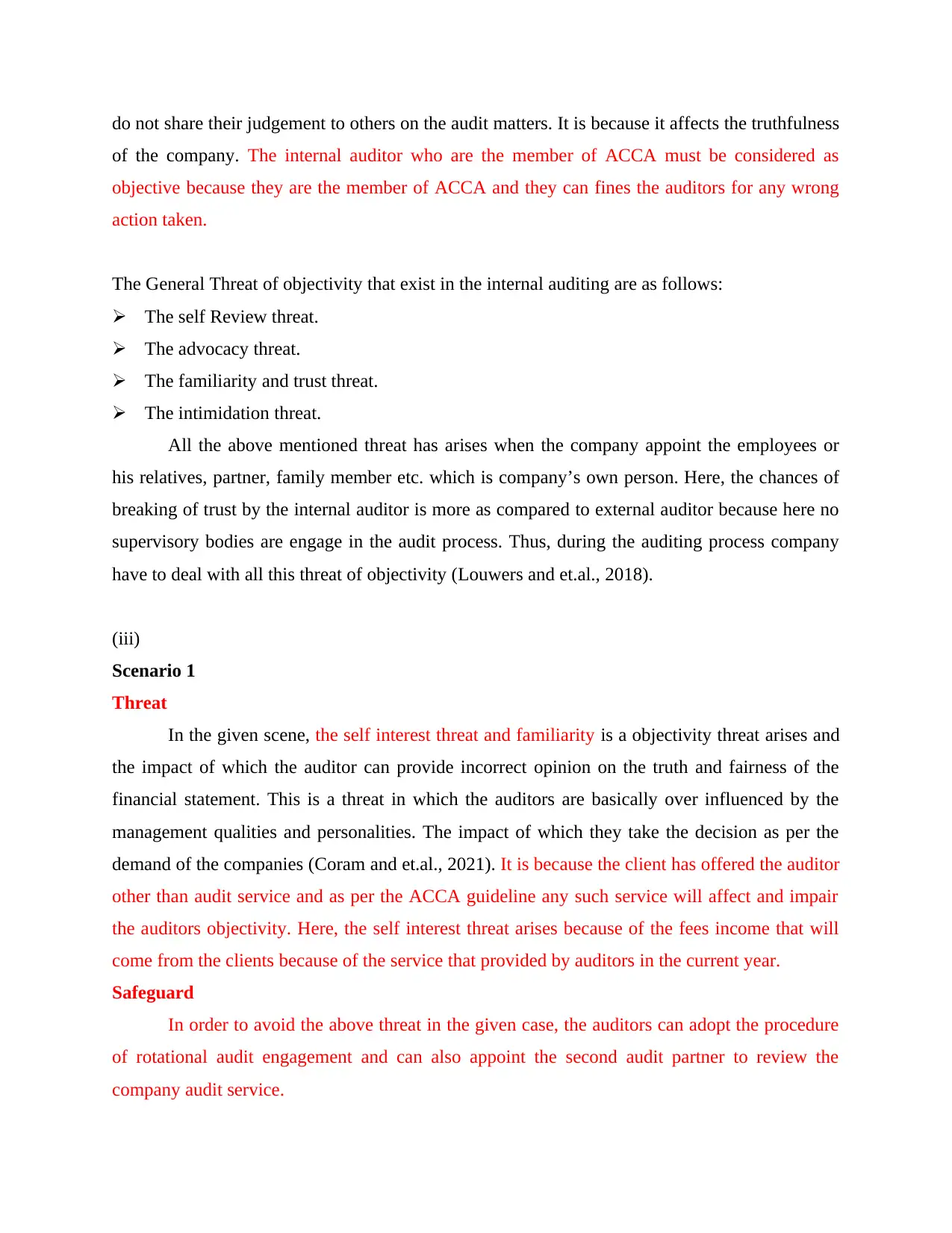
do not share their judgement to others on the audit matters. It is because it affects the truthfulness
of the company. The internal auditor who are the member of ACCA must be considered as
objective because they are the member of ACCA and they can fines the auditors for any wrong
action taken.
The General Threat of objectivity that exist in the internal auditing are as follows:
The self Review threat.
The advocacy threat.
The familiarity and trust threat.
The intimidation threat.
All the above mentioned threat has arises when the company appoint the employees or
his relatives, partner, family member etc. which is company’s own person. Here, the chances of
breaking of trust by the internal auditor is more as compared to external auditor because here no
supervisory bodies are engage in the audit process. Thus, during the auditing process company
have to deal with all this threat of objectivity (Louwers and et.al., 2018).
(iii)
Scenario 1
Threat
In the given scene, the self interest threat and familiarity is a objectivity threat arises and
the impact of which the auditor can provide incorrect opinion on the truth and fairness of the
financial statement. This is a threat in which the auditors are basically over influenced by the
management qualities and personalities. The impact of which they take the decision as per the
demand of the companies (Coram and et.al., 2021). It is because the client has offered the auditor
other than audit service and as per the ACCA guideline any such service will affect and impair
the auditors objectivity. Here, the self interest threat arises because of the fees income that will
come from the clients because of the service that provided by auditors in the current year.
Safeguard
In order to avoid the above threat in the given case, the auditors can adopt the procedure
of rotational audit engagement and can also appoint the second audit partner to review the
company audit service.
of the company. The internal auditor who are the member of ACCA must be considered as
objective because they are the member of ACCA and they can fines the auditors for any wrong
action taken.
The General Threat of objectivity that exist in the internal auditing are as follows:
The self Review threat.
The advocacy threat.
The familiarity and trust threat.
The intimidation threat.
All the above mentioned threat has arises when the company appoint the employees or
his relatives, partner, family member etc. which is company’s own person. Here, the chances of
breaking of trust by the internal auditor is more as compared to external auditor because here no
supervisory bodies are engage in the audit process. Thus, during the auditing process company
have to deal with all this threat of objectivity (Louwers and et.al., 2018).
(iii)
Scenario 1
Threat
In the given scene, the self interest threat and familiarity is a objectivity threat arises and
the impact of which the auditor can provide incorrect opinion on the truth and fairness of the
financial statement. This is a threat in which the auditors are basically over influenced by the
management qualities and personalities. The impact of which they take the decision as per the
demand of the companies (Coram and et.al., 2021). It is because the client has offered the auditor
other than audit service and as per the ACCA guideline any such service will affect and impair
the auditors objectivity. Here, the self interest threat arises because of the fees income that will
come from the clients because of the service that provided by auditors in the current year.
Safeguard
In order to avoid the above threat in the given case, the auditors can adopt the procedure
of rotational audit engagement and can also appoint the second audit partner to review the
company audit service.
⊘ This is a preview!⊘
Do you want full access?
Subscribe today to unlock all pages.

Trusted by 1+ million students worldwide
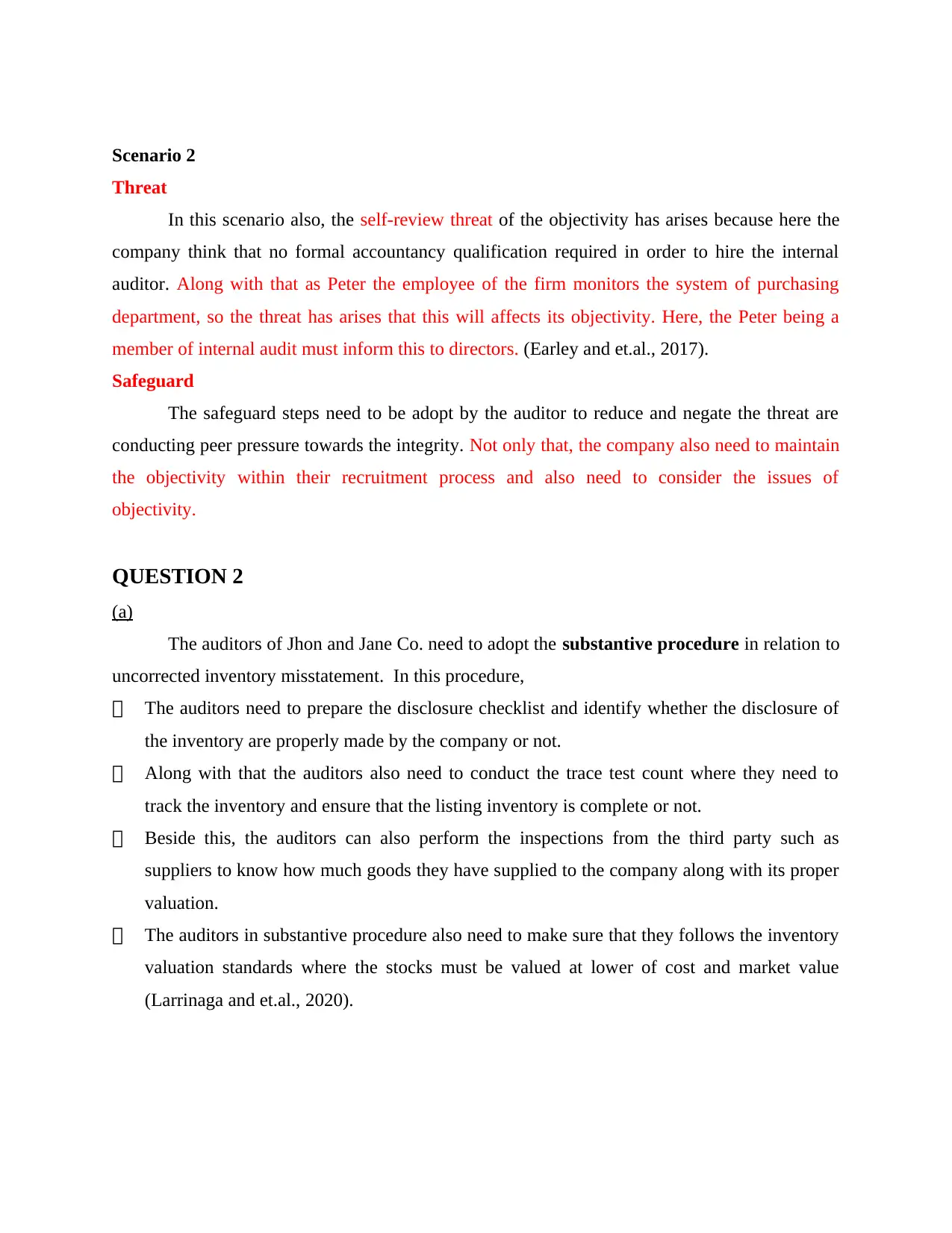
Scenario 2
Threat
In this scenario also, the self-review threat of the objectivity has arises because here the
company think that no formal accountancy qualification required in order to hire the internal
auditor. Along with that as Peter the employee of the firm monitors the system of purchasing
department, so the threat has arises that this will affects its objectivity. Here, the Peter being a
member of internal audit must inform this to directors. (Earley and et.al., 2017).
Safeguard
The safeguard steps need to be adopt by the auditor to reduce and negate the threat are
conducting peer pressure towards the integrity. Not only that, the company also need to maintain
the objectivity within their recruitment process and also need to consider the issues of
objectivity.
QUESTION 2
(a)
The auditors of Jhon and Jane Co. need to adopt the substantive procedure in relation to
uncorrected inventory misstatement. In this procedure,
The auditors need to prepare the disclosure checklist and identify whether the disclosure of
the inventory are properly made by the company or not.
Along with that the auditors also need to conduct the trace test count where they need to
track the inventory and ensure that the listing inventory is complete or not.
Beside this, the auditors can also perform the inspections from the third party such as
suppliers to know how much goods they have supplied to the company along with its proper
valuation.
The auditors in substantive procedure also need to make sure that they follows the inventory
valuation standards where the stocks must be valued at lower of cost and market value
(Larrinaga and et.al., 2020).
Threat
In this scenario also, the self-review threat of the objectivity has arises because here the
company think that no formal accountancy qualification required in order to hire the internal
auditor. Along with that as Peter the employee of the firm monitors the system of purchasing
department, so the threat has arises that this will affects its objectivity. Here, the Peter being a
member of internal audit must inform this to directors. (Earley and et.al., 2017).
Safeguard
The safeguard steps need to be adopt by the auditor to reduce and negate the threat are
conducting peer pressure towards the integrity. Not only that, the company also need to maintain
the objectivity within their recruitment process and also need to consider the issues of
objectivity.
QUESTION 2
(a)
The auditors of Jhon and Jane Co. need to adopt the substantive procedure in relation to
uncorrected inventory misstatement. In this procedure,
The auditors need to prepare the disclosure checklist and identify whether the disclosure of
the inventory are properly made by the company or not.
Along with that the auditors also need to conduct the trace test count where they need to
track the inventory and ensure that the listing inventory is complete or not.
Beside this, the auditors can also perform the inspections from the third party such as
suppliers to know how much goods they have supplied to the company along with its proper
valuation.
The auditors in substantive procedure also need to make sure that they follows the inventory
valuation standards where the stocks must be valued at lower of cost and market value
(Larrinaga and et.al., 2020).
Paraphrase This Document
Need a fresh take? Get an instant paraphrase of this document with our AI Paraphraser
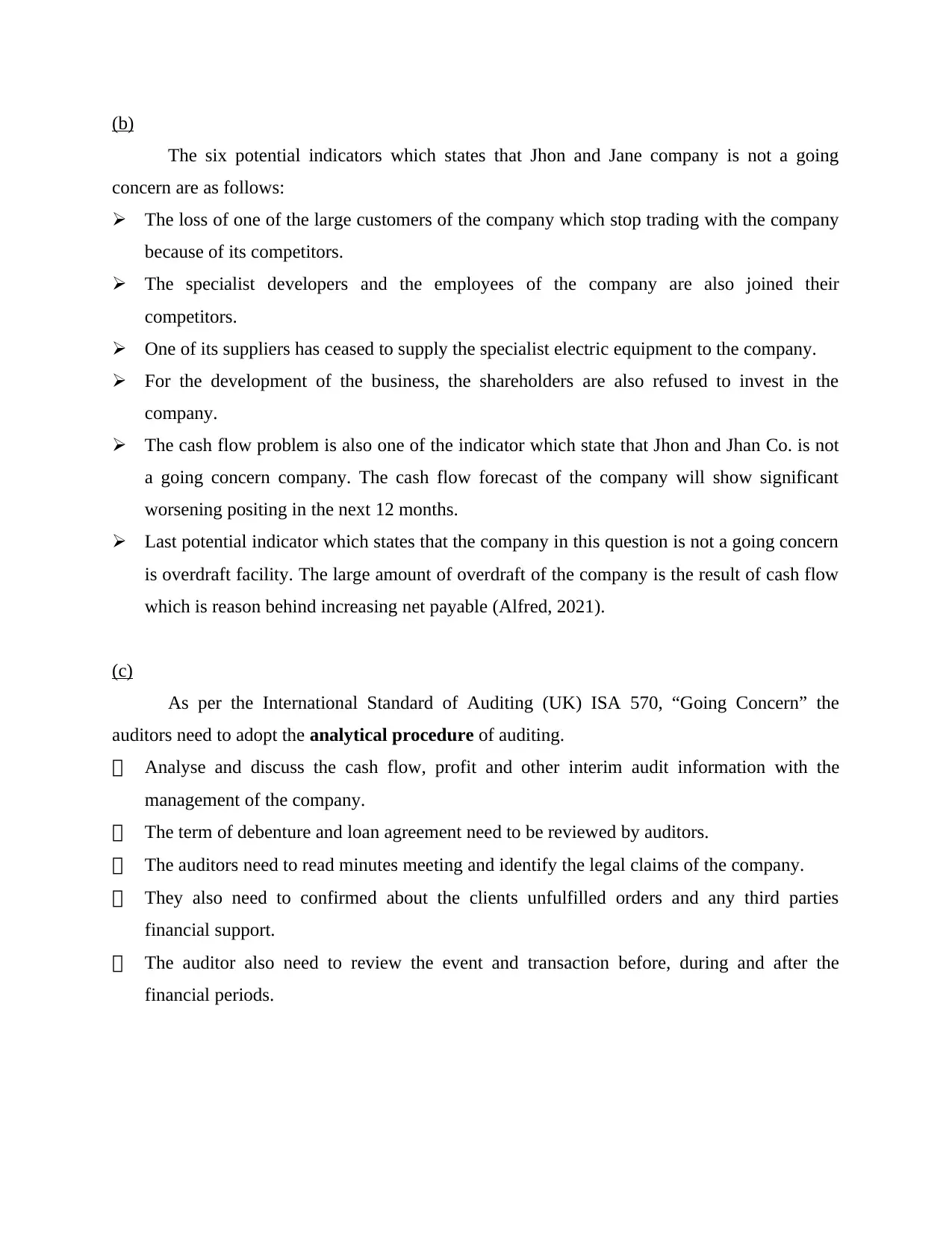
(b)
The six potential indicators which states that Jhon and Jane company is not a going
concern are as follows:
The loss of one of the large customers of the company which stop trading with the company
because of its competitors.
The specialist developers and the employees of the company are also joined their
competitors.
One of its suppliers has ceased to supply the specialist electric equipment to the company.
For the development of the business, the shareholders are also refused to invest in the
company.
The cash flow problem is also one of the indicator which state that Jhon and Jhan Co. is not
a going concern company. The cash flow forecast of the company will show significant
worsening positing in the next 12 months.
Last potential indicator which states that the company in this question is not a going concern
is overdraft facility. The large amount of overdraft of the company is the result of cash flow
which is reason behind increasing net payable (Alfred, 2021).
(c)
As per the International Standard of Auditing (UK) ISA 570, “Going Concern” the
auditors need to adopt the analytical procedure of auditing.
Analyse and discuss the cash flow, profit and other interim audit information with the
management of the company.
The term of debenture and loan agreement need to be reviewed by auditors.
The auditors need to read minutes meeting and identify the legal claims of the company.
They also need to confirmed about the clients unfulfilled orders and any third parties
financial support.
The auditor also need to review the event and transaction before, during and after the
financial periods.
The six potential indicators which states that Jhon and Jane company is not a going
concern are as follows:
The loss of one of the large customers of the company which stop trading with the company
because of its competitors.
The specialist developers and the employees of the company are also joined their
competitors.
One of its suppliers has ceased to supply the specialist electric equipment to the company.
For the development of the business, the shareholders are also refused to invest in the
company.
The cash flow problem is also one of the indicator which state that Jhon and Jhan Co. is not
a going concern company. The cash flow forecast of the company will show significant
worsening positing in the next 12 months.
Last potential indicator which states that the company in this question is not a going concern
is overdraft facility. The large amount of overdraft of the company is the result of cash flow
which is reason behind increasing net payable (Alfred, 2021).
(c)
As per the International Standard of Auditing (UK) ISA 570, “Going Concern” the
auditors need to adopt the analytical procedure of auditing.
Analyse and discuss the cash flow, profit and other interim audit information with the
management of the company.
The term of debenture and loan agreement need to be reviewed by auditors.
The auditors need to read minutes meeting and identify the legal claims of the company.
They also need to confirmed about the clients unfulfilled orders and any third parties
financial support.
The auditor also need to review the event and transaction before, during and after the
financial periods.
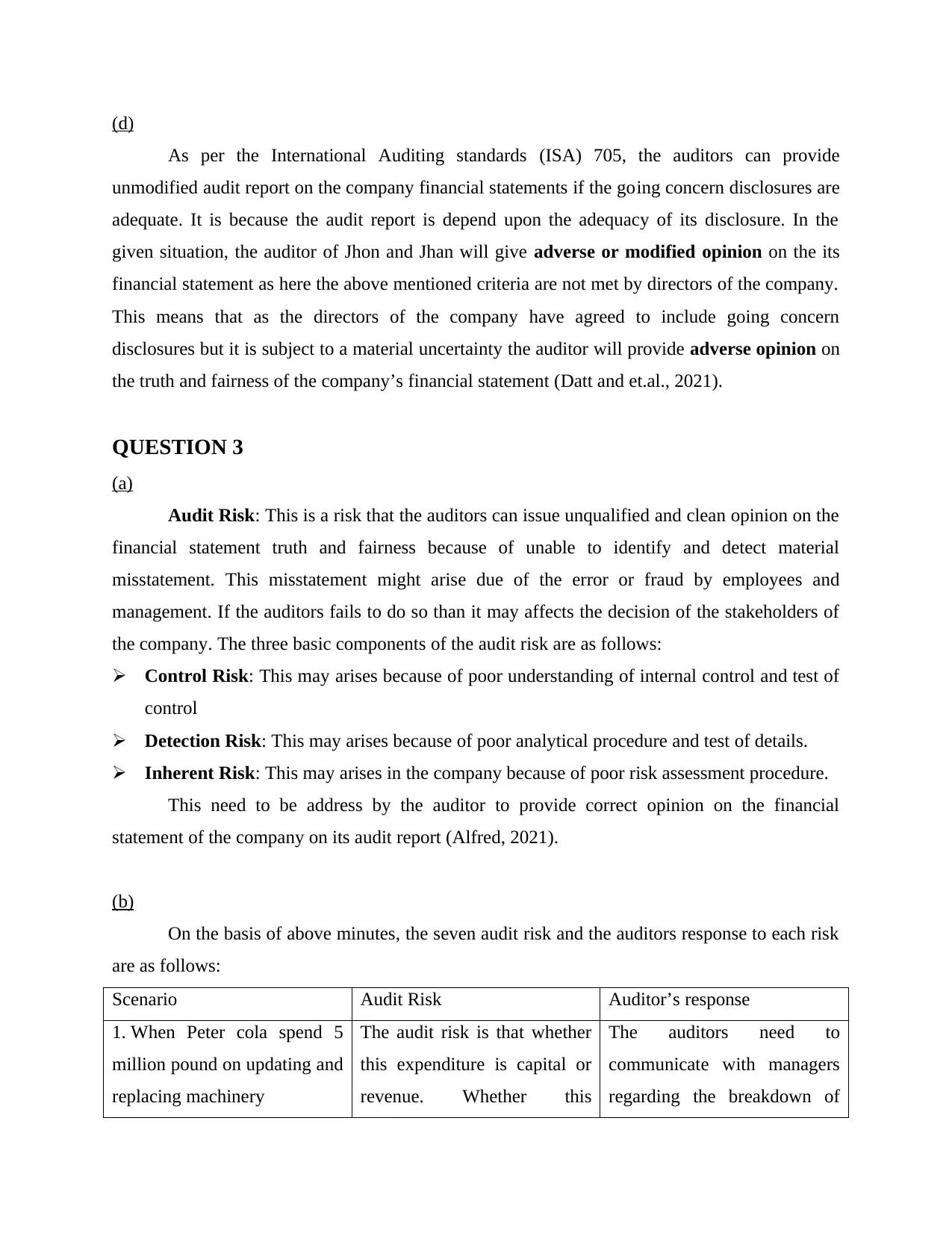
(d)
As per the International Auditing standards (ISA) 705, the auditors can provide
unmodified audit report on the company financial statements if the going concern disclosures are
adequate. It is because the audit report is depend upon the adequacy of its disclosure. In the
given situation, the auditor of Jhon and Jhan will give adverse or modified opinion on the its
financial statement as here the above mentioned criteria are not met by directors of the company.
This means that as the directors of the company have agreed to include going concern
disclosures but it is subject to a material uncertainty the auditor will provide adverse opinion on
the truth and fairness of the company’s financial statement (Datt and et.al., 2021).
QUESTION 3
(a)
Audit Risk: This is a risk that the auditors can issue unqualified and clean opinion on the
financial statement truth and fairness because of unable to identify and detect material
misstatement. This misstatement might arise due of the error or fraud by employees and
management. If the auditors fails to do so than it may affects the decision of the stakeholders of
the company. The three basic components of the audit risk are as follows:
Control Risk: This may arises because of poor understanding of internal control and test of
control
Detection Risk: This may arises because of poor analytical procedure and test of details.
Inherent Risk: This may arises in the company because of poor risk assessment procedure.
This need to be address by the auditor to provide correct opinion on the financial
statement of the company on its audit report (Alfred, 2021).
(b)
On the basis of above minutes, the seven audit risk and the auditors response to each risk
are as follows:
Scenario Audit Risk Auditor’s response
1. When Peter cola spend 5
million pound on updating and
replacing machinery
The audit risk is that whether
this expenditure is capital or
revenue. Whether this
The auditors need to
communicate with managers
regarding the breakdown of
As per the International Auditing standards (ISA) 705, the auditors can provide
unmodified audit report on the company financial statements if the going concern disclosures are
adequate. It is because the audit report is depend upon the adequacy of its disclosure. In the
given situation, the auditor of Jhon and Jhan will give adverse or modified opinion on the its
financial statement as here the above mentioned criteria are not met by directors of the company.
This means that as the directors of the company have agreed to include going concern
disclosures but it is subject to a material uncertainty the auditor will provide adverse opinion on
the truth and fairness of the company’s financial statement (Datt and et.al., 2021).
QUESTION 3
(a)
Audit Risk: This is a risk that the auditors can issue unqualified and clean opinion on the
financial statement truth and fairness because of unable to identify and detect material
misstatement. This misstatement might arise due of the error or fraud by employees and
management. If the auditors fails to do so than it may affects the decision of the stakeholders of
the company. The three basic components of the audit risk are as follows:
Control Risk: This may arises because of poor understanding of internal control and test of
control
Detection Risk: This may arises because of poor analytical procedure and test of details.
Inherent Risk: This may arises in the company because of poor risk assessment procedure.
This need to be address by the auditor to provide correct opinion on the financial
statement of the company on its audit report (Alfred, 2021).
(b)
On the basis of above minutes, the seven audit risk and the auditors response to each risk
are as follows:
Scenario Audit Risk Auditor’s response
1. When Peter cola spend 5
million pound on updating and
replacing machinery
The audit risk is that whether
this expenditure is capital or
revenue. Whether this
The auditors need to
communicate with managers
regarding the breakdown of
⊘ This is a preview!⊘
Do you want full access?
Subscribe today to unlock all pages.

Trusted by 1+ million students worldwide
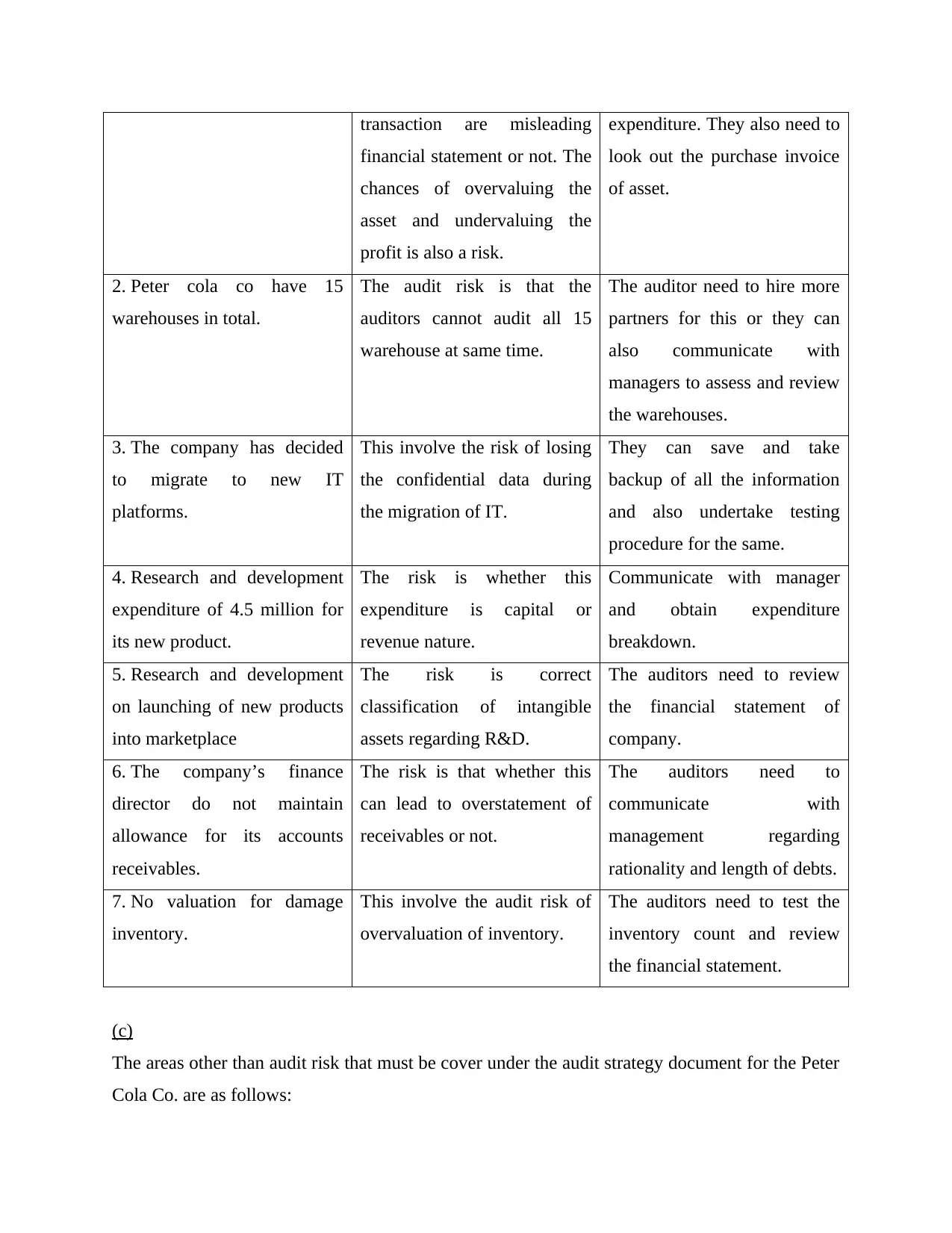
transaction are misleading
financial statement or not. The
chances of overvaluing the
asset and undervaluing the
profit is also a risk.
expenditure. They also need to
look out the purchase invoice
of asset.
2. Peter cola co have 15
warehouses in total.
The audit risk is that the
auditors cannot audit all 15
warehouse at same time.
The auditor need to hire more
partners for this or they can
also communicate with
managers to assess and review
the warehouses.
3. The company has decided
to migrate to new IT
platforms.
This involve the risk of losing
the confidential data during
the migration of IT.
They can save and take
backup of all the information
and also undertake testing
procedure for the same.
4. Research and development
expenditure of 4.5 million for
its new product.
The risk is whether this
expenditure is capital or
revenue nature.
Communicate with manager
and obtain expenditure
breakdown.
5. Research and development
on launching of new products
into marketplace
The risk is correct
classification of intangible
assets regarding R&D.
The auditors need to review
the financial statement of
company.
6. The company’s finance
director do not maintain
allowance for its accounts
receivables.
The risk is that whether this
can lead to overstatement of
receivables or not.
The auditors need to
communicate with
management regarding
rationality and length of debts.
7. No valuation for damage
inventory.
This involve the audit risk of
overvaluation of inventory.
The auditors need to test the
inventory count and review
the financial statement.
(c)
The areas other than audit risk that must be cover under the audit strategy document for the Peter
Cola Co. are as follows:
financial statement or not. The
chances of overvaluing the
asset and undervaluing the
profit is also a risk.
expenditure. They also need to
look out the purchase invoice
of asset.
2. Peter cola co have 15
warehouses in total.
The audit risk is that the
auditors cannot audit all 15
warehouse at same time.
The auditor need to hire more
partners for this or they can
also communicate with
managers to assess and review
the warehouses.
3. The company has decided
to migrate to new IT
platforms.
This involve the risk of losing
the confidential data during
the migration of IT.
They can save and take
backup of all the information
and also undertake testing
procedure for the same.
4. Research and development
expenditure of 4.5 million for
its new product.
The risk is whether this
expenditure is capital or
revenue nature.
Communicate with manager
and obtain expenditure
breakdown.
5. Research and development
on launching of new products
into marketplace
The risk is correct
classification of intangible
assets regarding R&D.
The auditors need to review
the financial statement of
company.
6. The company’s finance
director do not maintain
allowance for its accounts
receivables.
The risk is that whether this
can lead to overstatement of
receivables or not.
The auditors need to
communicate with
management regarding
rationality and length of debts.
7. No valuation for damage
inventory.
This involve the audit risk of
overvaluation of inventory.
The auditors need to test the
inventory count and review
the financial statement.
(c)
The areas other than audit risk that must be cover under the audit strategy document for the Peter
Cola Co. are as follows:
Paraphrase This Document
Need a fresh take? Get an instant paraphrase of this document with our AI Paraphraser
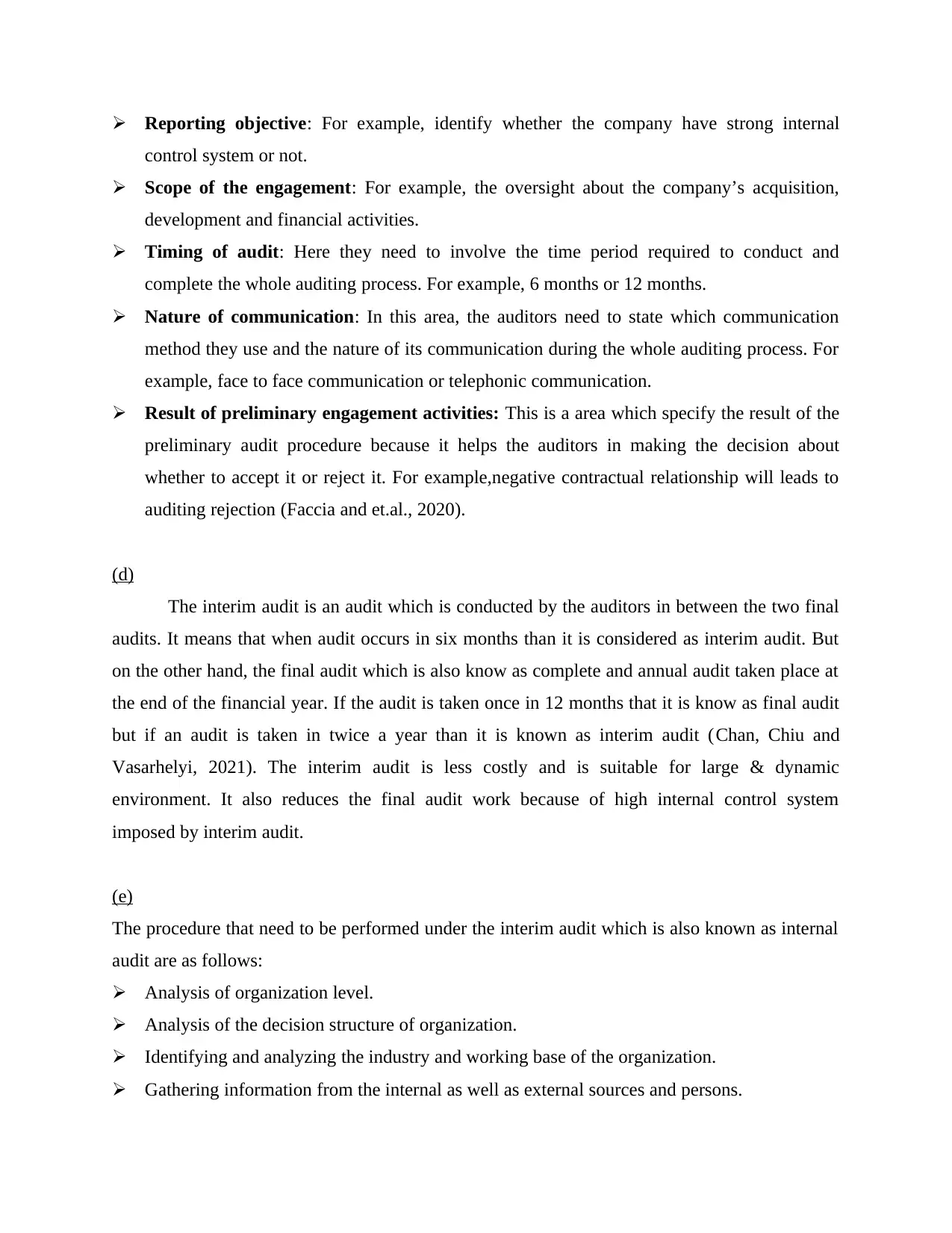
Reporting objective: For example, identify whether the company have strong internal
control system or not.
Scope of the engagement: For example, the oversight about the company’s acquisition,
development and financial activities.
Timing of audit: Here they need to involve the time period required to conduct and
complete the whole auditing process. For example, 6 months or 12 months.
Nature of communication: In this area, the auditors need to state which communication
method they use and the nature of its communication during the whole auditing process. For
example, face to face communication or telephonic communication.
Result of preliminary engagement activities: This is a area which specify the result of the
preliminary audit procedure because it helps the auditors in making the decision about
whether to accept it or reject it. For example,negative contractual relationship will leads to
auditing rejection (Faccia and et.al., 2020).
(d)
The interim audit is an audit which is conducted by the auditors in between the two final
audits. It means that when audit occurs in six months than it is considered as interim audit. But
on the other hand, the final audit which is also know as complete and annual audit taken place at
the end of the financial year. If the audit is taken once in 12 months that it is know as final audit
but if an audit is taken in twice a year than it is known as interim audit (Chan, Chiu and
Vasarhelyi, 2021). The interim audit is less costly and is suitable for large & dynamic
environment. It also reduces the final audit work because of high internal control system
imposed by interim audit.
(e)
The procedure that need to be performed under the interim audit which is also known as internal
audit are as follows:
Analysis of organization level.
Analysis of the decision structure of organization.
Identifying and analyzing the industry and working base of the organization.
Gathering information from the internal as well as external sources and persons.
control system or not.
Scope of the engagement: For example, the oversight about the company’s acquisition,
development and financial activities.
Timing of audit: Here they need to involve the time period required to conduct and
complete the whole auditing process. For example, 6 months or 12 months.
Nature of communication: In this area, the auditors need to state which communication
method they use and the nature of its communication during the whole auditing process. For
example, face to face communication or telephonic communication.
Result of preliminary engagement activities: This is a area which specify the result of the
preliminary audit procedure because it helps the auditors in making the decision about
whether to accept it or reject it. For example,negative contractual relationship will leads to
auditing rejection (Faccia and et.al., 2020).
(d)
The interim audit is an audit which is conducted by the auditors in between the two final
audits. It means that when audit occurs in six months than it is considered as interim audit. But
on the other hand, the final audit which is also know as complete and annual audit taken place at
the end of the financial year. If the audit is taken once in 12 months that it is know as final audit
but if an audit is taken in twice a year than it is known as interim audit (Chan, Chiu and
Vasarhelyi, 2021). The interim audit is less costly and is suitable for large & dynamic
environment. It also reduces the final audit work because of high internal control system
imposed by interim audit.
(e)
The procedure that need to be performed under the interim audit which is also known as internal
audit are as follows:
Analysis of organization level.
Analysis of the decision structure of organization.
Identifying and analyzing the industry and working base of the organization.
Gathering information from the internal as well as external sources and persons.
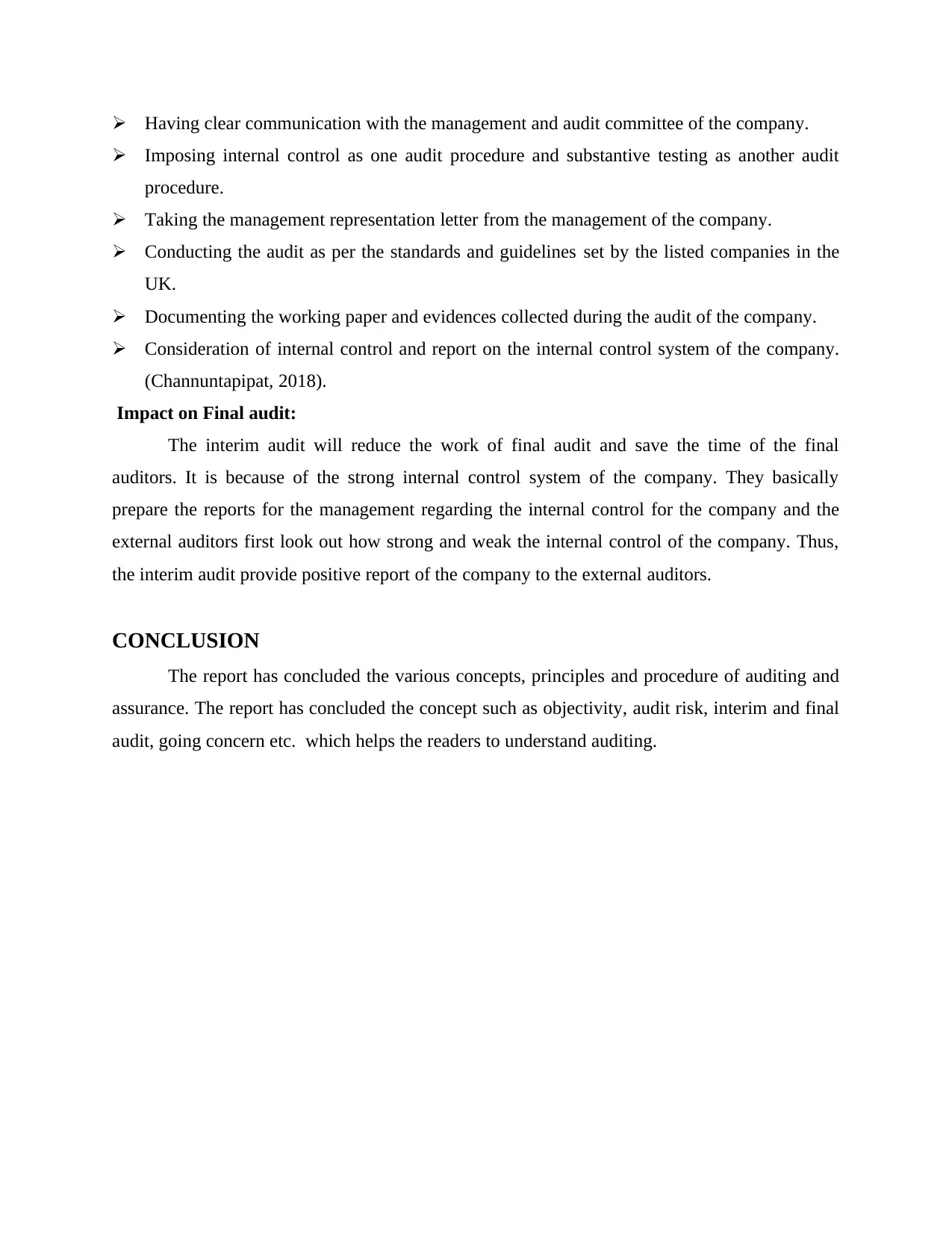
Having clear communication with the management and audit committee of the company.
Imposing internal control as one audit procedure and substantive testing as another audit
procedure.
Taking the management representation letter from the management of the company.
Conducting the audit as per the standards and guidelines set by the listed companies in the
UK.
Documenting the working paper and evidences collected during the audit of the company.
Consideration of internal control and report on the internal control system of the company.
(Channuntapipat, 2018).
Impact on Final audit:
The interim audit will reduce the work of final audit and save the time of the final
auditors. It is because of the strong internal control system of the company. They basically
prepare the reports for the management regarding the internal control for the company and the
external auditors first look out how strong and weak the internal control of the company. Thus,
the interim audit provide positive report of the company to the external auditors.
CONCLUSION
The report has concluded the various concepts, principles and procedure of auditing and
assurance. The report has concluded the concept such as objectivity, audit risk, interim and final
audit, going concern etc. which helps the readers to understand auditing.
Imposing internal control as one audit procedure and substantive testing as another audit
procedure.
Taking the management representation letter from the management of the company.
Conducting the audit as per the standards and guidelines set by the listed companies in the
UK.
Documenting the working paper and evidences collected during the audit of the company.
Consideration of internal control and report on the internal control system of the company.
(Channuntapipat, 2018).
Impact on Final audit:
The interim audit will reduce the work of final audit and save the time of the final
auditors. It is because of the strong internal control system of the company. They basically
prepare the reports for the management regarding the internal control for the company and the
external auditors first look out how strong and weak the internal control of the company. Thus,
the interim audit provide positive report of the company to the external auditors.
CONCLUSION
The report has concluded the various concepts, principles and procedure of auditing and
assurance. The report has concluded the concept such as objectivity, audit risk, interim and final
audit, going concern etc. which helps the readers to understand auditing.
⊘ This is a preview!⊘
Do you want full access?
Subscribe today to unlock all pages.

Trusted by 1+ million students worldwide
1 out of 14
Related Documents
Your All-in-One AI-Powered Toolkit for Academic Success.
+13062052269
info@desklib.com
Available 24*7 on WhatsApp / Email
![[object Object]](/_next/static/media/star-bottom.7253800d.svg)
Unlock your academic potential
Copyright © 2020–2025 A2Z Services. All Rights Reserved. Developed and managed by ZUCOL.





